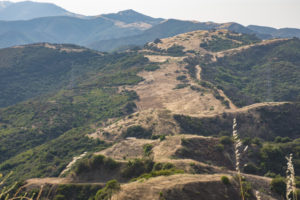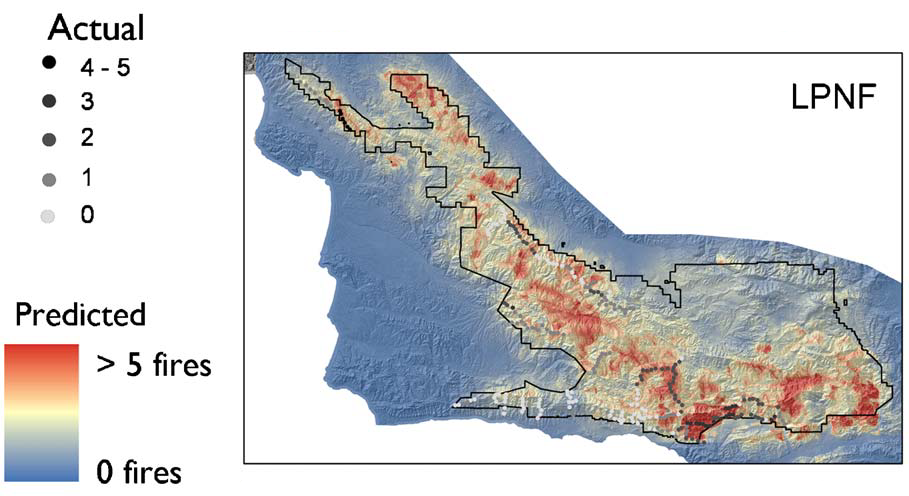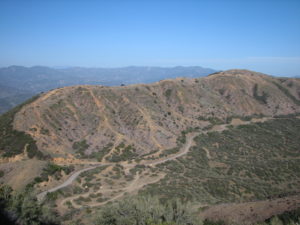
The Camino Cielo Fuel Break — one of the largest in the Los Padres National Forest — along the Santa Ynez Mountains crest. Shown here is a large stretch of the fuel break that was breached by the 2017 Whittier Fire (bright green growth on the left is only one year old after the fire).
A fuel break is a strip of land that is purposely converted from one vegetation type to another for firefighting purposes. In our region, fuel breaks are typically long strips of land that are converted from native chaparral to non-native and invasive grasses and weeds. They can be hundreds to thousands of feet wide.
The concept behind fuel breaks is to create a corridor that facilitates firefighter movement during a wildfire. These areas are often where certain wildfire suppression techniques are employed such as backfires or burn-outs (when firefighters set their own fire to burn the vegetation in front of an advancing wildfire).
Fuel breaks are often confused with fire breaks and fire lines, which are constructed differently and used for different purposes. A fire line is typically 10 feet wide or less and is almost always built during wildfire suppression. They can be built by hand crews or by using machinery and involve removing the vegetation down to bare soil. Fire breaks are a strip of land 20-30 feet wide where vegetation has also been removed down to bare soil. Like fire lines, fire breaks are usually created under emergency conditions during wildfire suppression with the intention of acting as barriers to further wildfire spread. They are typically created with a bulldozer and are thus sometimes called “dozer lines.”
Do Fuel Breaks Work?
We have long known that fuel breaks do not passively stop wildfires, and they are not very effective when manned by firefighters—especially under extreme weather conditions. In 1977, the Forest Service published a handbook on fuel breaks. In it they have a section titled “What Fuelbreaks Cannot Do” which states this:
A strong criticism of the fuelbreak approach to fire control is that the headlong rush of a large fire can carry it across a wide break-manned or not under extreme conditions.
Numerous scientific studies have since confirmed that fuel breaks generally do not stop wildfires burning under extreme conditions such as low humidity and high wind, even when firefighters are present.
A 2011 study confirmed on the Los Padres National Forest specifically what the Forest Service seemed to already know in the 1970s. The researchers found that fuel breaks helped stop a wildfire approximately 46% of the time between 1980 and 2007. However, this was only true when firefighters were able to access the fuel breaks quickly ahead of a fire. Generally, fuel breaks do not passively stop a wildfire as winds can blow embers up to a mile in front of a fire. These embers can then ignite vegetation on the other side of a fuel break, which is why we often see wildfires “jump” fuel breaks, roads, and other barriers.
 As firefighters must be present on a fuel break for it to have a chance of impacting the progression of a wildfire, scientists recommend that fuel breaks be built immediately adjacent to communities rather than in remote areas. The most destructive types of wildfires are wind-driven and generally occur in high heat and low moisture conditions. These are the types of wildfires are least likely to stop. Such fires move across the landscape too quickly, not allowing enough time for firefighters to deploy onto fuel breaks in their path.
As firefighters must be present on a fuel break for it to have a chance of impacting the progression of a wildfire, scientists recommend that fuel breaks be built immediately adjacent to communities rather than in remote areas. The most destructive types of wildfires are wind-driven and generally occur in high heat and low moisture conditions. These are the types of wildfires are least likely to stop. Such fires move across the landscape too quickly, not allowing enough time for firefighters to deploy onto fuel breaks in their path.
The 2017 Thomas Fire progressed far beyond over 70 miles of fuel breaks as well as three major highways as it moved from Santa Paula to Santa Barbara. The fire progressed far too quickly for firefighters to access these existing fuel breaks in time. The limited firefighting resources that were available were instead deployed to urban areas to protect lives and properties.
Ecological Impacts of Fuel Breaks
Along with limited effectiveness, fuel breaks also impact surrounding landscapes in several ways. Typically, fuel breaks in our region are first created through a process called mastication — the mechanical crushing of all vegetation. When building fuel breaks, agencies use heavy equipment to masticate the native chaparral. Fuel breaks are also bulldozed to initially remove vegetation.
Because fire season generally lasts from June until December each year, fuel break construction occurs in spring to avoid using heavy equipment in fire-prone during dry conditions and to avoid using such equipment in muddy conditions following winter rains. Unfortunately, this means that fuel break construction and maintenance often happens in the most important season for local and migratory birds. A 2018 study found that mastication of chaparral—which is the most common method of fuel break construction in our region—is particularly devastating to bird communities.
Fuel breaks are also dominated by non-native, invasive plants such as highly flammable cheatgrass, wild oats, and black mustard. These plants have been shown to dry out earlier in the year and spread wildfire more quickly. Fuel breaks thus offer a springboard from which invasive species can invade the adjacent chaparral and other ecosystem types. And because fuel breaks lack the dense, native chaparral and are therefore more easily accessible, they often become areas of off-road vehicle trespass. This can in turn cause further erosion and other issues.
A Better Way to Protect Communities
The most effective vegetation management occurs immediately around structures and directly adjacent to communities. Establishing and maintaining smart defensible space is key to protecting homes and firefighter safety during a wildfire. Other steps such as retrofitting existing structures with fire-safe materials and curbing development in fire-prone areas are also critical in better protecting communities from the impacts of wildfire.
You can read more about wildfire in our region by clicking here.







